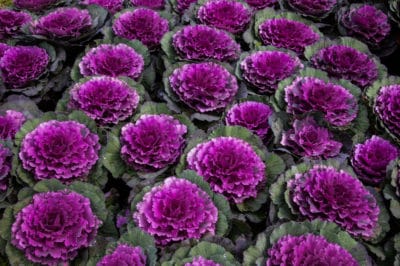Varieties and Colors
Cabbage flowers and kale flowers are very similar, but kale flowers have fringed (ruffled), serrated, or feathered edges on the leaves while cabbage flowers have smooth edges on the leaves. While cabbage flowers may or may not form heads, the inner and outer leaves show contrasting colors with the inner leaves taking on the vibrant colors. Varieties of ornamental cabbage include:
- Color Up – grows in upright columns; inner leaves of fuchsia, blush pink, or white; outer leaves green
- Osaka — fast-growing, compact cabbage shapes; red, white, or pink inner leaves; bluish-green, semi-scalloped outer leaves
- Pigeon – flattened cabbage shape with white or red centers
- Tokyo – perfectly round cabbage shapes; blue-green outer leaves; red, white, or soft pink inner leaves
When to Plant Your Ornamental Cabbage?
As with autumn leaves, chlorophyll obscures the color in your ornamental cabbage until temperatures drop below 60°F (16°C), but the colors don’t begin to fully develop until temperatures drop below 50°F (10°C). A frost or prolonged cold weather brings the colors to their most vibrant.
If you plant your ornamental cabbage too early, it will remain green and become leggy instead of growing low to the ground.
If you choose to start your ornamental cabbage from seeds yourself, you should sow your seed three to four month before you want the full size plants to transfer to you flowerbeds. At the latest, start your seeds six to 10 weeks before the first frost date for your area.
How to Choose Ornamental Cabbage Plants?
If you are purchasing fully grown plants to transfer to your flowerbeds, do not expect them to grow much larger. The plants you are purchasing probably have become root bound in the pot, and, once that happens, the cabbage will not grow larger. So, buy the size cabbage you need to fill the space you have.
The leaves should all be the same length, and the center leaves should have at least some pale color. There should not be any holes in the leaves. The stems should be short.
How to Grow Ornamental Cabbage From Seed?
As mentioned, you should start your seeds at least six to 10 weeks before the first frost date for your area. If you don’t know when that date is, check with your local extension service.
Use a nutrient rich, sandy or loamy potting soil for vegetables or vegetables and herbs that has a pH of 6.5 to 6.8. Following the package directions, mix a granulated, slow-release organic fertilizer with a N-P-K (nitrogen-potassium-phosphate) ratio of 13-13-13 or 14-14-14 with the soil.
If you are growing your ornamental cabbage in containers, you can simply start the seeds in the containers, but it will be easier to keep the seeds under a light source if all of the pots are the same height. Cabbage should be grown in pots that are at least 12 inches deep and that allow at least 18 inches of space per cabbage. Otherwise, you can start your seeds in flats or cell packs.
Ornamental cabbage seeds need light to germinate, so lay them on top of the soil 2 inches apart, but do not cover them. Keep the seeds in a sunny spot or under a grow light or a cool white florescent light in a location where the temperature remains between 65-75°F (18-24°C).
The first leaves that appear will be the cotyledons. These are not true leaves but a part of the seed that provides nourishment while the roots and true leaves develop. To prevent your cabbages from becoming root bound, you should transplant cabbages started in flats or cell packs to pots as soon as the first true leaves appear.
Allow the top inch of the soil to dry out between each watering, but check daily to make sure that the deeper soil remains evenly moist.
Where to Plant Ornamental Cabbage Plants?
Ornamental cabbage plants grow well in USDA Plant Hardiness Zones 3 through 9. Choose a location in full sun or partial shade with rich, well-drained soil. Avoid locations where the soil becomes muddy or where water collects in puddles. Placing mulch around your ornamental cabbages helps to maintain even soil moisture.
Ornamental cabbages create dramatic displays when planted together in large groups. They also provide striking borders for ornamental grasses or plantings of asters, chrysanthemums, and
snapdragons. Pansies, petunias, ornamental peppers, and herbs, among other plants, work well with cabbages planted in containers.
How to Transplant Ornamental Cabbages?
Transplant your seedlings when they are 4 to 5 inches tall and space them 18 to 24 inches apart. Whether you are transplanting seedlings or full grown cabbages, dig a hole deep enough so that the lowest leaves rest on the ground.
Having Your Ornamental Cabbage and Eating It, Too
Ornamental cabbage is edible and is filled with the same nutrients as culinary cabbage, but it’s grown for its looks, not its taste or tender texture. The leaves are tough and bitter. If you want to use it to add color to your plate, boil it once or twice before sautéing it in olive oil with some strongly flavored accompaniments such as garlic. If you have grown your ornamental cabbage organically, you can use it as a garnish or as a decorative base for plating other foods.
